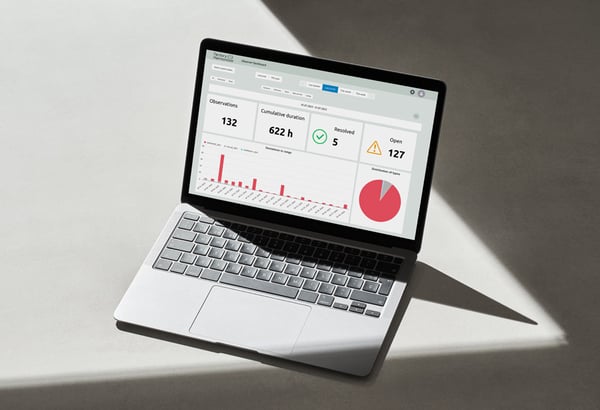Looking ahead to 2024, Forbes (2023) anticipates that companies will have streamlined and taken on a more strategic stance to leveraging their data. As a result, more companies will be ready for advanced data analytics to support their business objectives.
Despite these advances, concerns about data quality in the process industry are still common but worry not, reliable analytics providers with extensive experience in data collection and processing can transform data sets into valuable assets. As long as multiple sensors are collecting data digitally, data itself is often not a hindrance to analytics. If unsure about data quality, refer to our previous blog post before continuing to read about analytics here.
Analytics Providers
Due to the sheer amount of data available in production, the data processing and analytics thereof are often best handled using complex algorithms that can process and build thousands of data models in a short amount of time. While decisions regarding production should be left in the hands of expert operators and engineers, artificial intelligence and machine learning are best handled by a secure analytics provider.
Once data collection is in place, the focus shifts to turning that data into valuable information. Choosing the right analytics provider for the analysis of production data requires careful consideration of key factors. In this blog post, we explore the essential elements that manufacturers should keep in mind when selecting an analytics solution tailored to their unique requirements. The key to unlocking these benefits lies in choosing an analytics provider that aligns with the distinctive needs of your production setup and your long-term strategic goals.
Notably, while digital control systems such as Distributed Control Systems (DCS), Programmable Logic Controllers (PLCs) or Supervisory Control and Data Acquisition (SCADA) are essential for capturing process data, their analytics realm does not extend beyond tracking the value of single-point variables. More advanced monitoring software on the other hand connects variables to one another, modelling the complete data landscape to provide easily attainable actionable insights for the end user.
1. Expertise in Industrial Processes
First things first, you want an analytics provider that really understands the complexity that is industrial processes. While the role of intelligent monitoring software is to minimize the use of human resources for data analytics, every software is at the end of the day built by a human. Without an understanding and an appreciation of the dynamic environment that is manufacturing, the software may lack abilities to e.g., adapt to rapid changes in the process or may focus on incorrect measurements to enable optimal results. Ensure that the analytics tools provided are made with your manufacturing processes in mind for more productive and profitable production.
2. Compatibility is Key
You don't want your analytics tool to be the odd one out in your existing systems. The ideal provider offers a solution that easily fits and connects to what you already have in place, whether this is the latest technology or legacy systems. Think of it like finding a puzzle piece that seamlessly connects. This compatibility ensures a smooth transition to a more data-driven way of working without causing disruptions to your existing procedures.
3. User-Friendly
In the fast-paced world of manufacturing where labor shortages are often a reality, simplicity is crucial. Choose an analytics provider whose tool is not only powerful but also easy to use and learn. You do not want to spend hours on training every time someone new joins the team – there are plenty of other things on the to-do list. The goal is furthermore to make anomaly management a team effort, encouraging everyone to seamlessly be part of solving problems and improving processes. The quality of production should not differ depending on the staff available at hand. Thus, having a fancy tool that no one bothers to learn is about as useful as having no tool at all in place, though the second option is cheaper.
4. Time is of Essence
While talking about spending hours on training it is also important to consider the time spent on the implementation project as well as on software and model updates. The reality is that anything that is outsourced will always require some effort and knowledge from your own experts. The time required however varies from hours to weeks between different providers. Hence, while looking for a provider, ask them for concrete time estimates required from your team. You will also want to look for a provider who can provide continuous analytics without regular breaks for system updates, or who you regularly need to call up to make changes to the model in case there are updates to your processes.
5. Instant Gains and Scalable Solutions
Your analytics partner should bring immediate benefits to the table while also aligning with your long-term strategic goals. Can they provide insights that fit your production needs and efficiency targets right now? But more importantly, can they evolve as your business grows or changes? This adaptability ensures continuous improvement and the ability to tackle challenges that may pop up down the road.
6. Clear Insights
No one likes a mysterious black box. Your analytics provider should not only tell you 'what' is happening but also 'why.' This understanding is crucial for making smart decisions and utilizing the expertise of your dedicated workers on the ground. Notably, while information is great, too much information can be too much. Choose a provider that allows you to delve deep into the root causes of problems but also provides you with a manageable overview of the current state of production. A good provider doesn't just predict; they offer solutions that empower your team to proactively handle issues and optimize processes.
Conclusion
In a world where data is everywhere but often overlooked, choosing the right analytics provider can be a game-changer for your production processes. Focus on finding a partner that understands your needs, plays nice with your current systems, is easy on your human capital investment, and empowers your team with easy-to-use tools. Remember, the key is to invest wisely, embrace innovation, and team up with a partner who shares your vision for a smarter, data-driven future. It's all about making strategic choices that fit the dynamic nature of modern manufacturing.
Want to hear more about how we at SimAnalytics take these key factors into consideration? Book a call with one of our experts.



